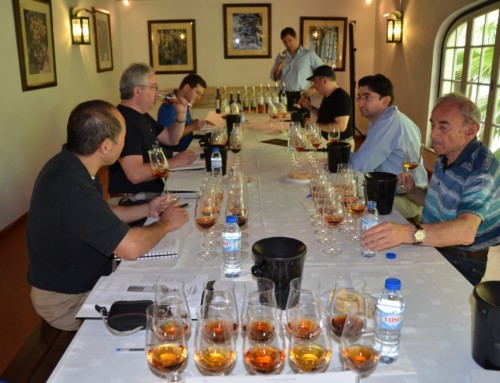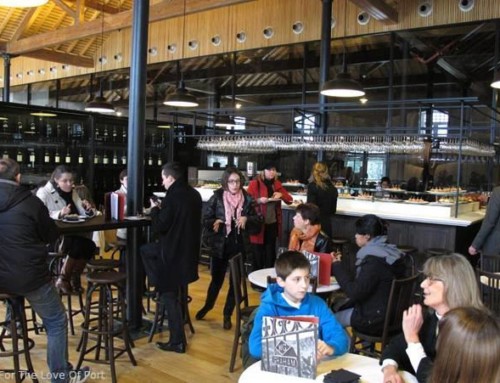Luisa Borges has deep roots in the Douro even though she grew up in Lisbon, Portugal as her father was raised in the Douro village of Celeirós and his ancestors (Vieira de Sousa) on his mother’s side of the family was involved in growing and supplying grapes to prominent Port shippers and producing small amounts of their own Port too. In Lisbon, Luisa studied oenology and viticulture at the Instituto Superior de Agronomia before she made the move to the Douro in 2008 to begin her career as the winemaker and marketer for her family’s Port and DOC wines.
Joining the family Port business at the ripe age of 23, Luisa made her very first Vintage Port a year later in 2009, with grapes grown on her family’s Quinta do Roncão Pequeno’s vineyard. They were then fermented in lagares at their Quinta da Agua Alta property. Coincidentally, Luisa is a cousin of Pintas/Passadouro winemaker, Jorge Serodio Borges.
Luisa’s family owns three properties in the Douro region which allows for a variety of micro-climates and diversity of vineyard expositions. They have been producers for larger Port shippers for many years and have occasionally provided access to their family’s old Tawny Port stocks.
The smallest property of the three is called Espinhal de Cima and is near Ferrão, virtually next door, just upriver and a drop inland from Quinta do Crasto, near the Douro River, part of … and behind … the larger Quinta da Agua Alta. The vineyard varies in altitude from 124 to 370 meters, maintaining modern parcels facing East, South and West and due to its location, it can get very hot there.
If the name of this Quinta is familiar, it is likely due to its use by Churchill’s as a Single Quinta Vintage Port. Whereas the grapes used to go to Taylor’s and also to Cockburn’s; Luisa’s family enabled Johnny Graham to have access to great grapes when he started up his new company after selling Graham’s to the Symington Family in 1970. Looking through my cellar, I found a few Churchill’s Vintage Ports from 1990, 1992 and 1995 which all had “Agua Alta” on the label.
Quinta do Roncão Pequeno is not too far from Quinta da Romaneira, located between Pinhão and the Roncão Valley, but even closer and on the northeastern border of Quinta da Roêda. This quinta also sold grapes to Churchill’s and is a unique property with lots of history. Lastly, is Quinta da Fonte, a small property in Celeirós dating back to the 17th century, which is situated at altitude and provides some of the block planted grapes for Vieira de Sousa’s impressive white wine and white Ports, delivering freshness and stunning acidity.
In addition to Port, Luisa has now produced a fine Douro white and red wine too (the latter is still in cask). A 2008 LBV was literally just approved by the IVDP and will be bottled this year; in addition to an upcoming 20 year old Tawny; Luisa has also made a 10 year old White Port:
Vieira de Sousa 10 Year Old White Port – This 10 Year Old White comes from a minimum of two lots, a blend of 20 year old whites and some younger Ports too, but the average is somewhere between 15-20 years of age. Complex aromatics, very rich and sweet, nicely balanced by focused acidity and a superlative long finish. We tried this at the very beginning of the night while we were getting acquainted and I did not take detailed notes, but paid close attention nonetheless, and really liked its simplicity and harmony too. 92 points 6/2/12
2011 Espinhal de Cima Douro white wine – Produced from Rabigato, Viosinho and Gouveio grapes that elicited an ethereal tropical bouquet, a rarity in the Douro except for an occasional off-dry Moscatel. The heady perfume had an unusual aromatic floral and tropical infusion, but not overdone. I found myself returning to the glass often for the exotic aromas of marmelo, fresh ripe guava melon, white peach, honeysuckle and orange blossoms. For such a young Douro white, I was struck by the richness and light oily texture of this wine, which was all fermented rather dry, in stainless steel. It showed a bit of ripeness and was loaded with crisp acidity too. It paired quite nicely with several different appetizers before us. This 2011 white will improve for several years and in fact, I’d like to see how it will evolve for the next 3-4 years, although it should drink at its best from 2013 through 2019. 91+ points 6/2/12
Vieira de Sousa 10 Year Old Tawny Port – Bottled 2011. Old school Tawny with some “Douro bake” evident on the nose, in a good way, (but not over-the-top) along with figs, prunes and stewed fruits. It is extremely tasty, but light in acidity and has just enough to carry the sweetness of the sultana, cinnamon stick and date flavors. Texturally silky soft and very easy to sip on, this Tawny is a blast-from-the-past stylistically, with some rusticity and freshness as well. The average age of the blend lies between 12-15 years. Nicely done! I had this again with Luis Seabra and a few guests from the Fortification Tour a few nights later and everybody was seriously enthused by the distinctive character of this 10 Year Old. 92 points 6/2/12
2009 Vieira de Sousa Vintage Port – 100% foot trodden with four days of fermentation; long compared to the norm which averages 2 days. All grapes come from the family’s vineyards. Briary boysenberry and floral fragrances with a faint hint of vanilla. Young, approachable, round and balanced with purity of fruit, freshness and plenty of vibrant acidity along with refined soft tannins. Primary and very tasty, this 2009 is a worthy cellar defender with aging potential of 10-15 years. A very solid, impressive first effort by this young rising star. 90 points 6/2/12





Leave A Comment
You must be logged in to post a comment.